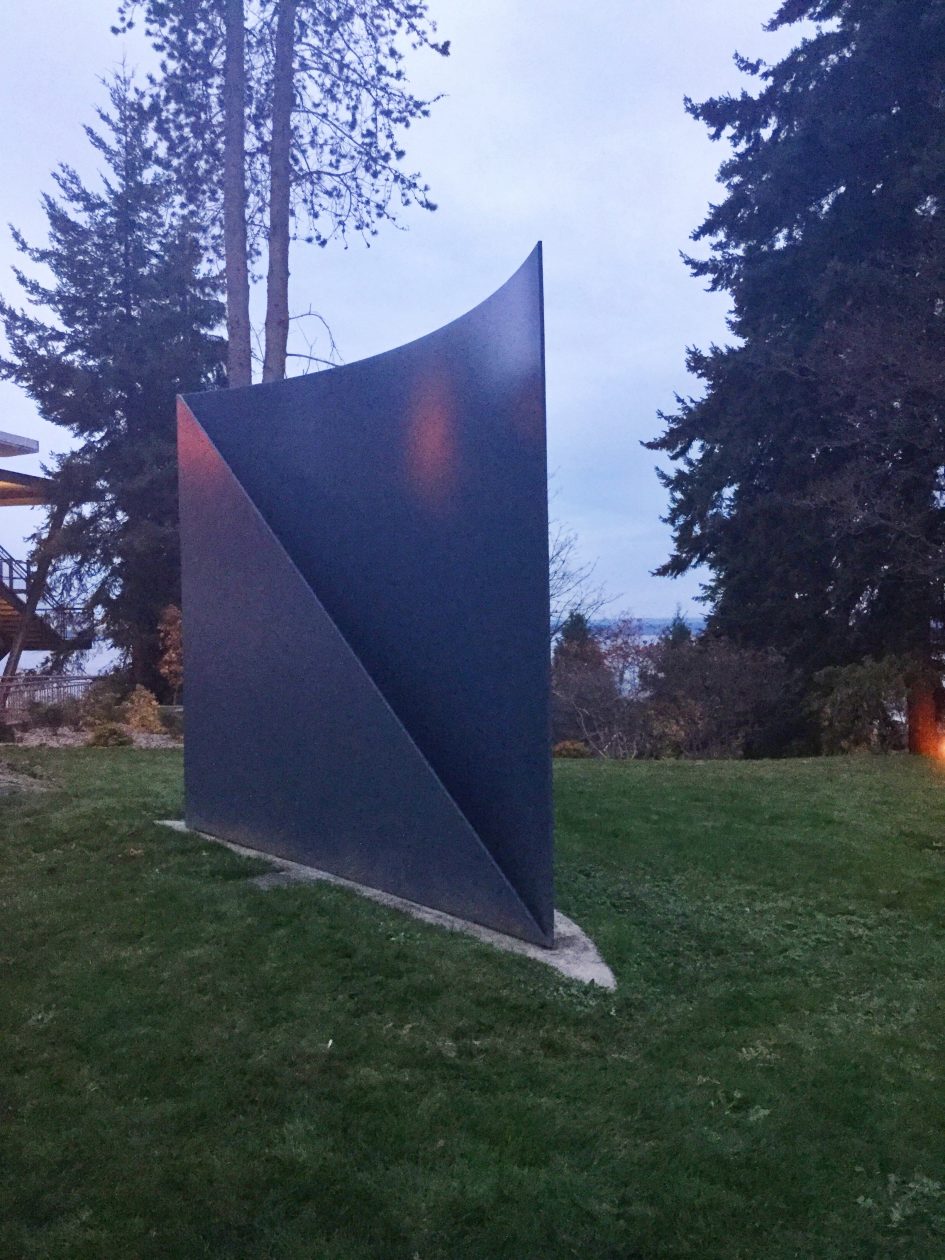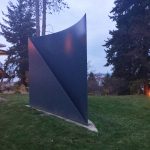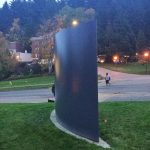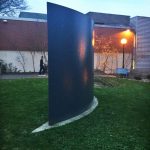About the Sculpture
Curve/Diagonal was created in 1979 by artist Robert Maki, a Washington local and Western Washington University alumni. While originally intended for a gallery exhibition, the piece was repurposed and given as a gift as a part of the Virginia Wright fund and installed on campus in 1981, placed specifically on North Campus by Maki himself. To Maki, the placement of his work Curve/Diagonal was and is very important because of its exposure to the sun. Like many of Maki’s works and sculptures, it’s minimalist and very large scale at approximately eight feet high and ten and a half feet wide. As an artist, he uses his sculptures and other works as a mode for changing our views and ideas of perception and how it can change under a variety of circumstances. Curve/Diagonal is a good example of his ideas of perception. He used this specific piece to conduct a couple studies on sunlight and shadow. The different conditions placed upon the sculpture, like the direction the sun hits the piece and the angles of the shadows, guide us to see the restructuring of the work and how it’s dimensions change throughout the day.
About the Artist
Born in Walla Walla, Washington, Robert Maki was raised as a Washington native. He studied drafting followed by engineering drawing for more than four years and attended Western Washington University, receiving is Bachelor’s Degree in 1962 and his Master of Fine Arts (M.F.A.) in 1966. Throughout his career, he taught mechanical drawing, art and art history. This was before he became a full-time artist. As a successful artist, he is exhibited in museums and galleries across the nation and across the world, including Los Angeles, Seattle, Portland, Canada, Japan, and France. Through his works he molds our perceptions, plays on how we see things, and has faith that they can speak for themselves.
“I think of my artwork as a fragment of something larger. My sculpture involves illusionary structures and situations lending to perceptual ambiguity in both interior and large-scale outdoor concepts.”
-Robert Maki
The strongest influence of his work lies in his past, specifically from 1938 to 1948 when he hopped freight trains with his father. He is strongly impacted by five strong women in his immediate family as well as different works of art he’s seen in his young life, including Winslow Homer, Caster Friedrich, Antoine Pevsner and Naum Gabo.
Maki and the 70’s
Western Washington University in the 70’s was undergoing a shift in the idea of “engaged excellence”, requiring that art be present on campus. With this idea, including art on campus would increase student, faculty, community, and public engagement. The 70’s in the United States and across the world (when Maki created Curve/Diagonal) were a time of social justice advocacy, political unease, and the fight for peace. It was the time of Watergate, the normalization of relations with China, the start of earth day and environmental advocacy, the height of the cold war, the end of the energy crisis that came with a major increase of oil prices, and the continual movement into the computer age. Within the art world, it was the time of Andy Warhol, making pop art mainstream and becoming a major influence on many artists at the time and in the future. Social justice is a major influencer on Maki’s work. People in that time had (and some still do) very closed-minded opinions and a low ability to accept others the way they are.
Artist Statement
These images taken of Curve/Diagonal are a reaction to Maki’s concepts of incorporating natural light and simplicity into the project. Since the Curve/Diagonal is perceived to have varying dimensions dependent on the changing light throughout the day, we decided to photos and video of this sculpture closer to sun down in order to gain a different perspective on the piece while including more color from the setting sun. The remaining light from the sun emphasized the importance of shadow in the piece and made the sculpture seem thinner than earlier in the day. The main purpose of these photos were to pay homage to Maki’s ideas of minimalism and his appreciation and playfulness with how he can use the natural world, and natural light in this instance, to create a natural interaction between the viewer, the sculpture, and the world around them.
Created By:
Hailey Jones and Carsten Olufson
Photos By:
Carsten Olufson
Sources
Alexander, Michelle. THE NEW JIM CROW. New, 2012., Print.
Inc., STQRY. “Canary II – Robert Maki.” STQRY. Area360, 2017. Web.
Janowiecki, Michelle. “Protesting in the 1960’s and 1970’s.” Protesting in the 1960s and 1970s. American Archive, Web.
Lindman, Dale. “Posts about Robert Maki on PROGRAPHICA: In the Mind of the Artist.” PROGRAPHICA In the Mind of the Artist. WordPress, 14 Apr. 2015. Web.
Phaidon Editors, comp. The 20th Century Art Book. Phaidon, 1999. Print.









Leave a Reply